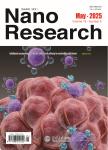版权所有:内蒙古大学图书馆 技术提供:维普资讯• 智图
内蒙古自治区呼和浩特市赛罕区大学西街235号 邮编: 010021

作者机构:Department of Chemical Engineering Monash University Clayton VIC 3800 Australia The Melbourne Centre for Nanofabrication 151 Wellington Road Clayton VIC 3168 Australia Key Laboratory of Industrial Ecology and Environmental Engineering and State Key Laboratory of Fine Chemicals School of Environmental Sciences and Technology Dalian University of Technology Dalian 116024 China Advanced Computing and Simulation Laboratory (AχL) Department of Electrical and Computer Systems Engineering Monash University Clayton VIC 3800 Australia
出 版 物:《Nano Research》 (纳米研究(英文版))
年 卷 期:2016年第9卷第2期
页 面:415-423页
核心收录:
学科分类:081705[工学-工业催化] 07[理学] 070205[理学-凝聚态物理] 08[工学] 0817[工学-化学工程与技术] 080501[工学-材料物理与化学] 0805[工学-材料科学与工程(可授工学、理学学位)] 0702[理学-物理学]
基 金:DSDBI of the Victorian Government supported by the Australian Research Council Discovery Programme
主 题:matryoshka-caged gold nanorods galvanic replacement reaction 4-nitrophenol catalysis surface plasmon resonance
摘 要:Matryoshka-caged gold nanorods (mCGNRs) were successfully synthesized by alternating between a seed-mediated silver-coating method and galvanic replacement reactions (GRRs). As the number of matryoshka layers of the mCGNRs increased, the plasmon resonance peak broadened and was red-shifted, and the catalytic activity towards the reduction of 4-nitrophenol (4-NTP) increased. When mCGNRs with 6 layers were used as nanocatalysts in the reduction of 4-nitrophenol, the reaction rate coefficient was 5.2- and 3.7-times higher than that of the gold-nanorod- and caged-gold-nanorod-catalyzed reductions of 4-nitrophenol, respectively. In addition, the surface-plasmon-resonance-based absorption of light enhanced the catalytic performance of the mCGNRs. With the support of a polyurethane foam, the mCGNRs synthesized in this study can be applied as recydable heterogeneous catalysts for the reduction of 4-nitrophenol.